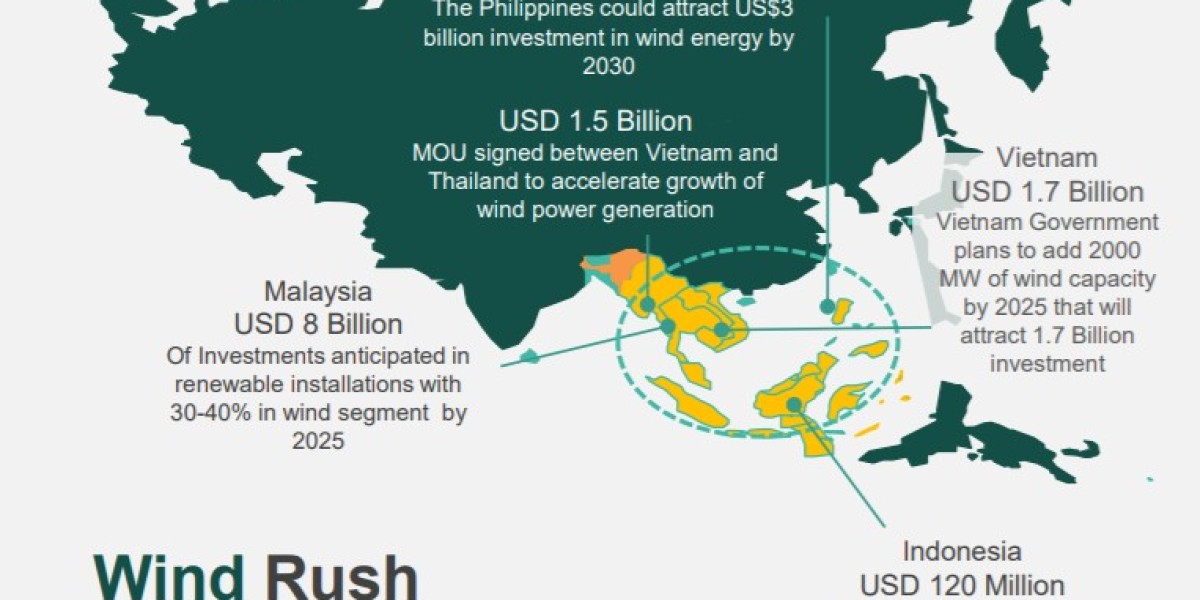Introduction:
In the pursuit of sustainable energy solutions, the global wind turbine market has emerged as a powerful force, transforming the landscape of electricity generation. As the world grapples with the challenges of climate change and seeks cleaner alternatives to conventional energy sources, wind turbines have risen to prominence. In this blog, we will explore the dynamics, trends, and key factors driving the wind turbine market's growth and its crucial role in the transition toward a more sustainable energy future.
The Global Wind Turbine Market Landscape:
Rising Demand for Clean Energy: The increasing global awareness of environmental issues and the urgency to combat climate change have fueled a growing demand for clean, renewable energy sources. Wind power, harnessed through wind turbines, has become a cornerstone in meeting this demand, offering a reliable and sustainable alternative to traditional fossil fuels.
Technological Advancements: The wind turbine market has experienced significant technological advancements over the years. Innovations in turbine design, materials, and manufacturing processes have led to increased efficiency, lower costs, and improved performance. Higher hub heights, longer rotor blades, and advanced control systems are among the innovations driving the market forward.
Government Support and Policies: Many governments around the world are actively promoting the adoption of wind energy through supportive policies, incentives, and regulatory frameworks. Initiatives such as feed-in tariffs, tax credits, and renewable energy targets have encouraged investments in wind energy projects, propelling the growth of the wind turbine market.
Economic Viability: The decreasing costs of wind energy have contributed to its economic viability, making it increasingly competitive with conventional energy sources. As the levelized cost of electricity (LCOE) for wind power continues to decline, more countries and businesses are recognizing the economic benefits of investing in wind turbines.
Key Components of the Wind Turbine Market:
Onshore vs. Offshore Wind Turbines: The wind turbine market is divided into onshore and offshore segments. Onshore wind turbines are more common and cost-effective, while offshore turbines offer the advantage of stronger and more consistent winds, albeit at a higher installation cost. The offshore segment is gaining traction due to its potential for higher energy yields.
Turbine Size and Capacity: The trend in the wind turbine market is toward larger and more powerful turbines. High-capacity turbines are becoming more prevalent, allowing for increased energy production and efficiency. This trend is driven by advancements in materials and design, enabling the development of turbines with larger rotor diameters and hub heights.
Manufacturing and Supply Chain: The manufacturing and supply chain of wind turbines play a crucial role in the market. Global competition has driven manufacturers to optimize production processes, reduce costs, and enhance the quality of components. Supply chain resilience is essential for ensuring a steady and reliable flow of turbine components.
Grid Integration and Smart Technologies: Integrating wind energy into existing power grids poses challenges due to the intermittent nature of wind. Smart grid technologies and advanced energy storage solutions are becoming increasingly important to enhance grid stability and reliability. Innovations in grid integration technologies are key contributors to the market's evolution.
Market Challenges and Future Outlook:
Intermittency and Storage: One of the primary challenges facing the wind turbine market is the intermittent nature of wind energy. The development of efficient energy storage solutions is crucial for addressing the variability in wind power generation and ensuring a stable and reliable energy supply.
Land Use and Aesthetics: Onshore wind farms require substantial land areas, leading to concerns about land use and visual aesthetics. Striking a balance between maximizing energy production and minimizing environmental impact is a challenge that the industry must navigate.
Capital Investment and Financing: While the long-term economic benefits of wind energy are evident, the initial capital investment required for wind projects can be a barrier. Access to financing and the availability of supportive financial mechanisms are essential for the continued growth of the wind turbine market.
Competing Energy Sources: The wind turbine market faces competition from other renewable energy sources, such as solar and hydropower. The interplay between these sources, along with advancements in energy storage technologies, will shape the future energy mix.
Conclusion:
The wind turbine market stands at the forefront of the global transition to clean and sustainable energy. As technological innovations continue to drive efficiency gains and government support fosters industry growth, wind turbines are poised to play a central role in meeting the world's escalating energy demands. While challenges remain, the winds of change are propelling the industry toward a future where wind power takes center stage in the global energy landscape. The journey is dynamic and challenging, but the destination—a cleaner, more sustainable energy future—is well worth the pursuit.

![Forum Update: Path of Exile's Key Issues [Oct '23]](https://insta.tel/upload/photos/2025/02/mo3x1a3AzWEJnQsgvWSA_27_7b270f0c5e23017d6099755e3124d9b4_image.png)

